
First, a recap from yesterday. We met at the Harriet Beecher Stowe House in Cincinnati at the corner of Gilbert Ave. and Beecher street. It would have been nice to actually visit the house, but apparently the Ohio Historical Society can't get anyone to work there. There were no cars in the lot, and whoever was there left lights on in the basement. However, it is a beautiful home and here is a picture of it:
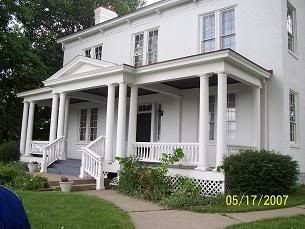
Today, we visited the Underground Railroad Freedom Center.
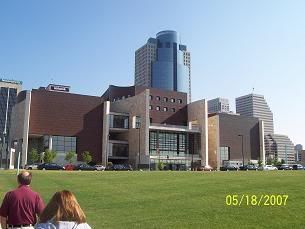
I had heard for a long time this place called the Guilt Center and had even joked myself at times that it should be made into a casino. However, having gone, I must say that the while I think the center focuses too much on this:

and not enough on this:
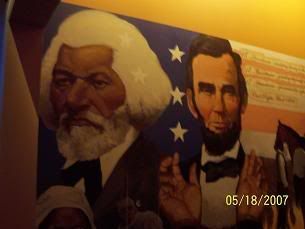
I still think there is value to be found in visiting the center. There were a number of interesting things to see and experience, however, I felt there was too much slavery and not enough Underground Railroad. We spent 3/4 discussing slavery and only 1/4 discussing the slaves who strove for freedom and the blacks and whites who tried to help them to the Promised Land.
One thing the center did was further relate the story of John Parker and John Rankin, two conductors on the URR. Parker was a former slave who bought his freedom and became a foundryowner and inventor in Ripley, OH. He gained such a reputation for bringing slaves across the Ohio he had a huge price on his head. Parker worked with Rev. John Rankin, whose house at the top of a hill overlooking the Ohio River provided a beacon for many. He and his family sheltered many slaves and helped them on their way. I had been to the Rankin House previously, but the dramatization in the museum brought it home for me, and makes me want to further explore the past in my county of Brown. It makes me wonder how many slaves and conductors travelled the same routes I do throughout the county, and what ghosts still speak from the URR. While I think the museum has a way to go, its use of cutting edge audio technology to help guide people through the exhibits as well as the interactive "escape to freedom" displays show a great deal of promise. Now if we could stop the shameless self promotion by the celebs on the board as well as all the corporate sponsors. This museum really should be called the slavery museum at the present, because it focuses more on that than the quest for freedom. I would have liked to have seen the Holocaust exhibits (what does this have to do with URR??) but we ran out of time. At present, I give this museum between a C and C-. If it begins to cover more about the URR and less about chains and guilt, then it will go up. However, I think all in Ohio should go, as it is quite educational, even if at times it does get a bit much. I wonder why Oprah and Co. did not talk more about the Democratic party being the party of slavery....hmmm...
Below are some pics I took with some descriptions. Enjoy!
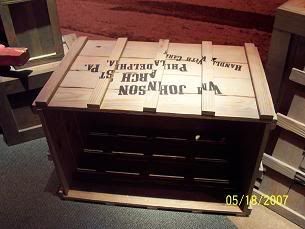
This is a reproduction of the box that Henry Box Brown used to ship himself to freedom. He spent days in the box, and used it as a pulpit after he came North to illustrate the need for freedom. As an illustration, my sister attempted to get into the box here:
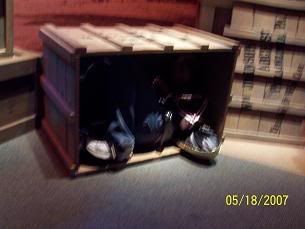
Diagram of how to ship slaves in boats across the Atlantic, aka the Middle Passage:
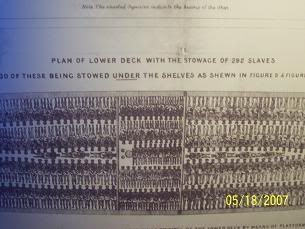
Slave Pen taken from Kentucky and Reconstructed inside the Center, the pen was where slaves were kept, women and men, chained, and where they took care of each other and often were separated for sale:
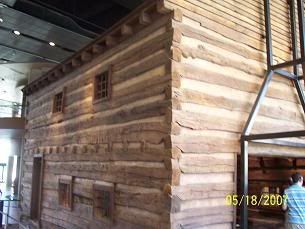
Listing of slaves sold, the interesting thing was they were all Christian names, showing part of the depersonification:

Mural depicting the hardship of the Middle Passage, being sold into slavery:
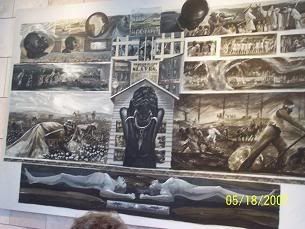
One of the first things you see upon entering the museum is this quilt, which tells the story of Ohio and slavery, through the prism of the creator's ancestors. It is very interesting and creative in terms of expressing the details:
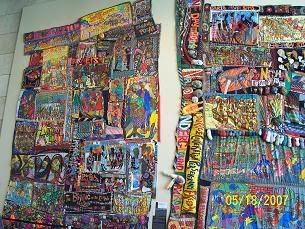
A reenactor and me:

And lastly, the eternal flame lit to represent freedom FOR ALL. May it never go out.
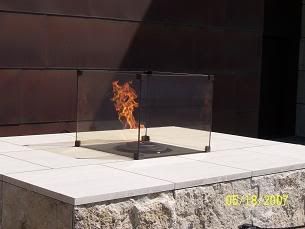
Update...revised and extended
I forgot to mention what I saw, which made me confused as whether to be happy or sad. There were several school groups at the museum. Some of the children were rapt with the stories and exhibits. However, a predominant group acted like they were at a romper room and paid little attention to the history of the struggle or the Underground Railroad...Who was this group? The black children. Most of the white children paid somber attention. They asked questions. They were rpat with stories of the docents.
Should I be happy that the black children are not caught up in the struggle as their forbears are, in terms of constantly harping on events of the past? Could it be this is a good thing in that slavery and the struggle for freedom don't mean much to them, that they are past it? Or, should I be sad in that they are ignorant of their own heritage and don't want to listen, only to grow up and cite it as a source of their own shortcomings, without knowing what it is all about? A sad commentary on the nature of the inner city school, as all of the children in question were from inner city schools.
While I am all for "getting over" the whole reparations and slavery issue; I was appalled at the lack of wanting to know your own heritage, at the lack of interest. Of course, the same can probably be said if you took them to Monticello or Gettysburg. I just found it interesting that the group most affected by the history the museum covers seemed not to give a damn.
